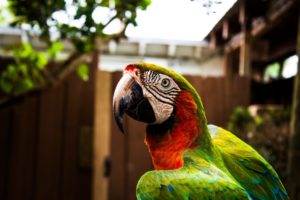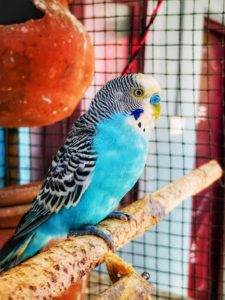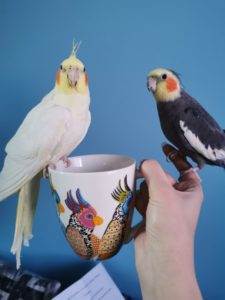






Hamsters are very popular pets. On average, these small, incredibly cute and funny rodents live quite short lives of only about 2–3 years.
Before you buy one
Make sure you’re ready for the arrival of the new household member. Minimize the animal’s stress connected with adapting to the new environment. What’s very important to keep in mind is that hamsters are loners – they feel best in their cage when they’re alone! Buying a second hamster to accompany the first one is always a recipe for disaster. No matter how big the cage is.
The basic principle is one cage per one hamster.
Hamsters have specific requirements. They need a lot of movement, plenty of space, are active at night and sleep a lot during the day, are very friendly, but also delicate – they should be handled with care. Right after the purchase, the hamster will be very stressed and may bite. You should leave it alone for a few days in a place specially prepared for it. Later, you may try to tame it with, for example, pieces of apples or gentle stroking. With time, your new friend will be happy to spend time with its human 🙂
Cage
It’s quite common to believe that such a small animal needs little space – this couldn’t be more wrong! This way of thinking has lead to all those stressed out hamsters locked in cages that are too small for them.
Hamsters feel happy only when they are able to move around a large territory. Therefore, the cage must occupy an area no smaller than 4,000 cm2, that is, 100x40cm (especially in the case of the Syrian hamster). However, in order for the cage to be as safe as possible, it shouldn’t be too big either. The hamster may try to do stunts and climb – he’d better not fall from too high a height. Also, keep in mind the spacing of the wires, so that the hamster can’t squeeze its head through. We recommend the Comfy Astro Wood 60 cage – a very stylish, spacious cage for rodents, fitted with wooden platforms and ladders. For a little furball that’s a bit of a rascal, the perfect cage will be Comfy Alfie Zinc 70 – a large cage with a galvanized grate and a tray made of high quality plastic that can withstand rodents with destructive tendencies. Or maybe you’d like to give your new buddy a real palace with a playground? Here you go! We have something special – Comfy Astro and Astro 2 – cages fitted with ramps that provide access to different levels, as well as with a house, running wheel, and tunnels. A true luxury paradise for your hamster! Make sure to also check out the Vetro Plus Nature model. It’s a two-level cage for small rodents, which combines the traditional wire cage design with a glass tray at the base to let you always keep an eye on what your pet’s doing. The included ladders will give small rodents an opportunity to exercise. Apart from said ladders, the complete set also includes a feeder, a water dispenser, and cotton bedding in a tube.
Remember to give your pet a little bit of freedom from time to time, and let it out of the cage at least once a week so that it can run freely around the house (under your watchful eye of course!).
‘Fitness accessories’ for hamsters
A hamster needs the right bedding, water dispenser, bowl, as well as a running wheel or a sandbox. Though not absolutely necessary, a house will be useful too.

At the Comfy store, there’s no shortage of houses 🙂 Here, you’ll find wooden (the best) houses with pitched or flat roofs, corner houses… as well as birchwood toys and various types of running wheels. Of course, you’ll also find balanced granulated food for rodents (a hamster’s diet should include grains, fruit, vegetables, and other plants), cotton bedding in a tube, hay, and wood shavings here. Everything you’re looking for! Buying a hamster ball for your pet is not a great idea though – it’s very loud and airless inside, the hamster has no contact with the ground, and its senses can’t detect external stimuli.
Diet
It’s good to feed your pet with carrots, seedless apples, bananas, corn, broccoli (but carefully and in small amounts), peas, pears, clovers, milk, and hay. Hamsters also like to eat a bit of a boiled egg or cheese, but it’s better not to serve it to them too often. After two days (tops!) you should remove from the cage whatever the hamster hasn’t eaten.
Which hamster to choose?

In Poland, the most popular hamsters are the Djungarian hamster and the Syrian hamster. Caring for these two species is very similar, but not identical.
Djungarian hamsters are more active and, therefore, require more space and more toys. Syrian hamsters are known for their tendency to be lazy, so you have to be careful not to let them turn into fat furballs that have difficulty moving.
What else should you keep in mind?
The teeth of hamsters (and all other rodents) grow all their lives. Their overgrowth may cause a lot of problems and pain to the animal. This is why it’s important to make sure that the hamster is always able to wear down its teeth. Another very important thing is to regularly clean the cage. It’s best to do this two or three times a week. Or, if necessary, more often.
Watch its health!
There’s still a belief out there that hamsters need to be bathed. This is absolutely not true! Really. A hamster will do great on its own and will clean its entire fur no problem. Baths are completely unnecessary and also dangerous for the hamster’s delicate health. If that wasn’t bad enough, they can expose the hamster to severe stress.
If you notice that the hamster is dispirited, has lost its appetite, and doesn’t want to play – you must take it to the vet. This is no joke! Hamster diseases can very quickly develop and lead to the death of your pet.
One of the greatest threats to hamsters is stress. It’s very important that your little friend’s cage be put in the right place, i.e., one that is quiet and peaceful. Keep the cage away from humidity/moisture, very sunny places, the TV, radiator, and any windows. The wires of the cage must be suitable for the size of the hamster. They must prevent the hamster from escaping or getting its head stuck.
Take good care of these fragile animals, and they will certainly become very grateful companions for you every day!
Those beautiful, extremely intelligent, exotic birds are some of the most popular pets, though they’re not meant for everyone. This is why they often face the sad fate of a homeless bird. Before you get a parrot, consider whether you are able to pay enough attention to it and whether you can afford to give it a healthy and happy life (some parrots can live even several dozen years!). Those birds can be man’s loyal friends, and deserve to get the same in return.

1. Consider various species of parrots – there are very many of them!
Small parrots – for example, budgies (about 18–20 cm) or Norfolk parakeets (also called the Tasman parakeet, Norfolk Island green parrot, or Norfolk Island red-crowned parakeet) (about 27 cm) – are very sociable and love contact with humans. It’s better to keep them in pairs or in larger flocks so that they don’t feel lonely.
Medium-sized parrots – for example, cockatiels (about 28–31 cm). Cockatiels are very intelligent and sociable. They quickly learn to imitate various sounds. Yellow-crowned amazons and turquoise-fronted amazons are way better than other species when it comes to the ability to imitate human speech. Grey parrots are slightly bigger (30–34 cm). They need special care and attention, because they become very attached to the owner and, neglected, may get depressed. They can also be jealous of their owner. Grey parrots are excellent at imitating human speech. They live for up to 60 years!
Large parrots – for example, macaws (about 46–95 cm), Alexandrine parakeets (about 58–62 cm), and cockatoos (50 cm or more). They live very long, even 40–60 years.

2. Where to buy a parrot?
A pet shop is the worst idea. Birds kept in pet shops are often sick, tired, and very expensive. It’s best to buy one from a proven breeder or take one from somebody who, for various reasons, can no longer care for their a bird friend.
3. Cage
It should be as large as possible so that the bird can move freely in it. The wings should never hit the cage’s walls. A decent cage isn’t cheap, but it’s really worth investing in! First of all, it has to be solid and well made, so that your parrot doesn’t hurt itself on, for example, a protruding wire. At Comfy, you’ll find cages in various sizes for small and large friends. We recommend, for example, the Arco, Vulcano, Saturno, and Orchidea models made of top quality materials. The Italian design and solid workmanship make the cages not only practical but also aesthetically pleasing. The sturdy plastic of the bottom tray ensures failure-free use for many years. The cages come with a special feeder that can be filled without being removed from the cage. Complete with: perches, a water dispenser, and a feeder.
4. Cage equipment
As the proud owner of such a magnificent bird, you must invest in a few gadgets. Parrots love them! At Comfy, you’ll find everything you need: water dispensers, cage accessories, toys, and swings. The latter are loved especially by grey parrots 🙂

5. The right food
For parrots, you can buy ready-made mixes that you’ll find in our stores (for example: the balanced food for budgies with or without fruit; the balanced food for medium-sized parrots; food sticks with two flavours – fruit and honey for budgies, the nuts stick for medium-sized parrots). Exotic birds also love greens, fruit, and vegetables. They eat rice, corn, and various grains too. It’s very important that they always have access to fresh water. Do not give avocados, rhubarb, onions, garlic, leeks, or chives to parrots.

6. Get ready to clean up
There’s no such thing as a tidy parrot that doesn’t make a mess around it. Parrots throw food, and poop everywhere. It would be ideal to place the cage on a wooden floor or on tiles. Get ready for vacuuming and mopping around the cage every day. You should also regularly (i.e. every day) clean the bottom of the cage (the tray), the bowls, and the toys.
7. Allow the parrot to get to know its surroundings
A parrot can’t be kept in a cage all the time. At least 2–3 times a week, let your friend out and let the bird fly freely around the house. Don’t forget to close the windows! Try to call the bird, and, if it finally sits on your shoulder or on your hand, consider this as a compliment to you, meaning that it accepts you and feels good around you.

8. A noisy individualist with character
Although those birds are – by nature – noisy, talkative, and make various sounds and calls, their noisiness is most influenced by the kind of upbringing they’re given. You should not allow a situation where they blackmail you with their screams. They’re extremely intelligent creatures and can easily figure out how to behave in order to get what they want. If the bird decides that it’s worth its while to scream, then it will keep doing this forever.
9. A sociable creature that loves to play
Parrots are lifelong companions – not decoration. They’re very sensitive, grow attached to the owner, and need not only a lot of space, but also your daily attention, interaction, and training. Sometimes, they can be jealous and possessive. They shouldn’t be left home alone for many hours. Large parrots need even more attention from the owner. Improper upbringing leads to pathological behaviour and even health problems. Sometimes, a parrot can peck in order to communicate that it doesn’t like some specific human behaviour or situation. Another thing to keep in mind: parrots are very ‘good at’ concealing diseases – you have to be a really caring and attentive owner to notice the early symptoms of a disease.

At a friend’s house, or maybe in a pet store, the eyes of an animal with a cute little mouth – just like the one in the picture – looked at you, and you instantly knew you wanted to have a rabbit, right?
Rabbits need a little more care than you might think. They shouldn’t spend their lives in a cage, but rather among people who give care and affection to their home companion. ‘Impulse buys’ and ignorance of the needs of rabbits lead to many of them ending up at shelters, foundations, and on the street.
Here’s what you need to know about rabbits before one of them comes to live in your home.
1. Rabbits live from 10 to 12 years. This is important considering that there is more to caring for a rabbit than just the daily feeding or cleaning. It’s a big commitment especially when the rabbit is a gift for a child. After some time, the child goes to school or college, and the rabbit becomes a burden for the parents. Speaking of children…
2. Rabbits are not the best pets for children. Sure, every child would like to have a lovely, fluffy, merrily hopping bunny just for him- or herself. But a child is not fit to be its primary caretaker. Rabbits are very sensitive animals and easy get startled by loud sounds and movements. Most of them don’t like to be held in people’s arms – they prefer lying next to humans (in nature, there are many lurking predators, so being lifted up and hugged is unnatural to them and can be very stressful).

3. Rabbits like to form couples. Although the beginnings of rabbit affection can be rough, there is nothing more beautiful than a long-eared couple in love. The rabbit couple support each other in difficult moments, feel safer together, take care of each other, have fun and play tricks on their owners together. By the way, it’s worth mentioning that rabbits should be castrated/spayed just like cats or dogs – primarily for health reasons, but also to avoid any undesirable behavior, or pregnancy.

4. Rabbits need movement and a lot of space. A large space allows them to run, hop, explore, and play. Before releasing the rabbit, you should secure any cables and make sure that the animal will be able to frolic in safety. And if a cage is needed, then it’s best to get one that’s large enough, such as, for example, Comfy Banny Plus – made of top quality materials. The sturdy plastic of the bottom tray ensures failure-free use for many years, while the Italian design and solid workmanship make the cage not only practical but also aesthetically pleasing.
5. Be ready to prepare your home so that it meets ‘rabbit requirements’. If you don’t have a place that you could turn into a ‘rabbit room’, or a place for a large cage, then perhaps your only option will be to give the rabbit some of your own space. And that means making some adequate preparations. Rabbit teeth never stop growing, so it’s very important that your long-eared friend always have access to good quality hay. This will allow it to wear down its teeth. Otherwise, it will use your electric cables and furniture. Plastic cable protection hoses should prevent this. As far as furniture is concerned, special barriers around the legs of chairs or animal deterrent sprays can help.
6. Rabbits need more than carrots (actually, in principle, they shouldn’t eat too many of those). Their diet should include fresh vegetables and dried herbs in the right proportions. Good nutrition is essential if you want to have a healthy and happy animal. This is why we recommend the Comfy Complete Food for Rabbits.

7. Rabbits need specialized veterinary care. Just like birds or reptiles, they need a professional who specializes in their species.
8. Rabbits have their own sense of time. They usually sleep during the day and at night. So, when are they active? At dusk and at dawn! This works great for evening snuggles on the couch, but not so much when you’re trying to fall asleep… Especially if they run freely around the house like this little guy.
All of this is a piece of cake for you and you’re sure you’ll be the perfect, loving owner for this cute little critter? Great! To show your love, buy responsibly.
WHERE TO GET A RABBIT?
Often, the first answer that comes to mind is the pet store. But this is not a good idea. The rabbits in stores are usually taken away from their mothers too early. Also, they’re often sick and have little chance of living into adulthood.
So, where can I find my dream pet? Instead of giving a rabbit to somebody as a present, give the rabbit a home as a present. Many of these animals are homeless, waiting at foundations for your love and a warm corner.
Check where you can buy
our products
Map of stores